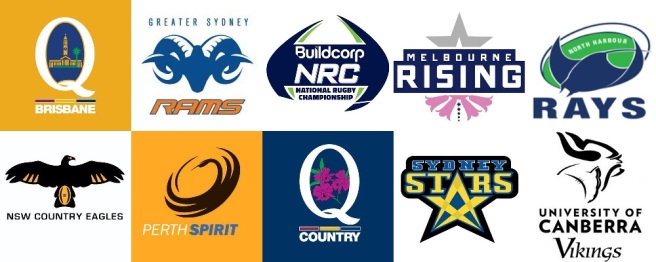
Photo from: http://www.bmcsport.com.au
With the 2015 regular Super Rugby (SR) season half completed, the contribution of the National Rugby Championship (NRC) is becoming progressively evident for each of the five Australian franchises.
The NRC was designed to fill a void in the Australian rugby development pathway between premier grade rugby competitions, such as the Shute Shield in Sydney and the Hospital Cup in Queensland, and Super Rugby.
As the SR season reaches the halfway point, the NRC appears to be achieving its goal as a development pathway, showing lots of promise for the future of Australian rugby.
To date, a number of rookies have graduated from the ranks of the NRC, making their SR debuts prior to the 2015 season’s halfway point.
A total of seventeen NRC players have earned their debuts for their corresponding Super Rugby franchises, with a few more making match day squads, however they are yet to take the field:
Brumbies; Nigel Ah Wong, Rory Arnold, James Dargaville, Sean Doyle and Lausii Taliauli
Force; Chris Heiberg, Kane Koteka
Rebels; Sam Jeffries (3 minutes last year), Tim Metcher (Bench but uncapped), Sefa Naivalu, Jonah Placid
Reds; Sef Faagase, Adam Korczyk (Bench but uncapped), Marco Kotze, Campbell Magnay, Duncan Paia’aua, Sam Talakai and Michael Gunn
Waratahs; Hugh Roach.
New South Wales Country Eagles‘ fly half, Sam Windsor has also recently been signed by Ulster.
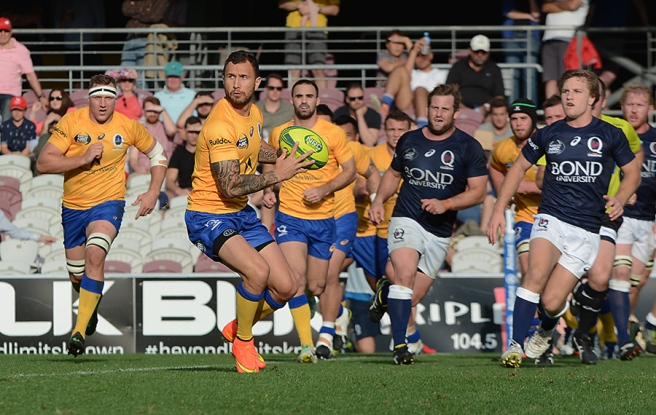
Sourced from: http://www.greenandgoldrugby.com
The largest benefit has been felt by the Queensland Rugby Union and the injury stricken Queensland Reds. Off the back of the success of Queensland’s NRC franchises, eight players have been rewarded with Elite Development Squad contracts, six of whom have taken the field, with the likes of Sam Talakai and Campbell Magnay becoming household names.
Australian Conference leaders, the ACT Brumbies have had their backline depth bolstered by Sydney Star’s utility back James Dargaville, who his team mates say is painted with the same brush as ex-Brumby and Wallaby Pat McCabe.
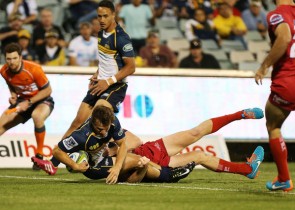
Photo from: http://www.zimbio.com
“I think he’ll probably develop a few more strings to the bow than I had, that might give him a bit more career longevity than I had” McCabe said of Dargaville.
Dargaville doesn’t seem to mind the comparison to the 24 test Brumbies stalwart, saying, “I feel I can get the best involvements by running hard and tackling hard. That’s the best way I can bring myself into a game, and if that’s similar to Pat McCabe then I guess we are similar in that way.”
Erstwhile Wallabies coaches Eddie Jones and John Connolly have backed another Brumbies’ player, the University of Canberra Viking’s Rory Arnold, who is staking his claim for a World Cup squad call-up.
Jones stated that “Arnold, at this stage of the season, would be close to the best rookie going around. He’s big, strong and aggressive”, while Connolly said that “Arnold has been one of the finds of the year. I think he’s fitting into a Brumbies pattern very well, he’s come along in leaps and bounds and he’s a real presence.” Adding that “[he has] been very impressed with him.”
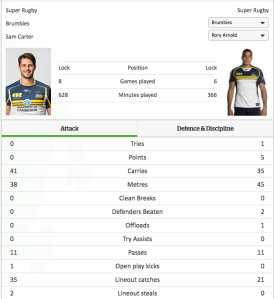
Sourced from: http://www.nzherald.co.nz
To date, Arnold is averaging 61 minutes, 7 tackles (85.7%), 5.8 runs for 7.5 metres and 0.3 tackle busts (TB) per game, with 1 try and 1 turnover conceded (TO) this season. Meanwhile, incumbent Wallaby and his Brumbies’ partner Sam Carter averages 78 minutes, 8.2 (81.5%) tackles, 5.1 runs for 4.75 metres per game with 0 TB and 14 TO all season.
That is remarkably similar statistics, surely tilting the way of Arnold, as Carter is 4 SR seasons his senior.
If Arnold can start to throw together some 80 minute games, the statistics would definitely start to sway in his favour. His major downfall at the moment is the lack of a lineout steal, while both players share very similar lineout wins per minute on the field.
Another potential second-row, Wallabies bolter Adam Coleman has also been making a name for himself in his debut Super Rugby season. He may not be an NRC graduate but he could potentially be a player of the future in Australian rugby.
Cheika has mentioned that the prospect of possibly fielding the largest second-row pairing in Wallabies history, Arnold (208cm and 127kg) and Coleman (204cm, 122kg), son of former Tongan captain Pau’u Afeaki, is exciting.
Incumbent Wallabies Rob Simmons (200cm and 115kg) and Sam Carter (200cm and 110kg) still remain the forerunners for the starting squad, however Arnold and Coleman are staking their claims. The pair would also have to overcome competition from the Wallabies largest player ever, 8 test capped lock Will Skelton (203cm, 135kg).

Melbourne Rebel’s Fijian flyer, Sefa Naivalu has rapidly developed a colt following after running rampant in his debut SR season. Naivalu starred for the NRC minor premiers the Melbourne Rising and has gone from strength to strength in the SR season this year.
Former Wallaby and Rebels’ player and current elite pathway/ coach education manager, Nic Henderson, believes the state of Melbourne rugby is on the rise and that Naivalu is proof of the development pathway of the Dewar Shield (premier grade) and Melbourne Rising.
Henderson stated that “to have Sefa come through that pathway so soon after the Rising started, sends the right message across, now we would love more players to come through like him.”
Rebels co-captain Scott Higginbotham believes that “Sefa’s incredible,” “he’s an absolute talent”, while ex-All Black Tamati Ellison believes that “if he keeps working, he can go to another level.”
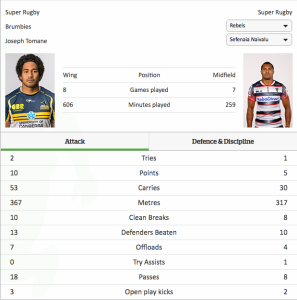
Sourced from: http://www.nzherald.co.nz
Naivalu has an average of 37 minutes, 3 tackles (87.5%), 4.3 runs for 45 metres, 1.4 TB, 1.1 line breaks (LB) and 1.75 offloads per game.
These stats shape-up well when in comparison to Wallabies’ and Brumbies’ winger Joe Tomane. Who with over twice as much game time on average (76 minutes), produces 2 tackles (64%), 6.6 runs for 45.8 metres, 1.6 TB, 1.25 LB and 1.25 offloads per game.
Hence, statistically this suggests that offensively Naivalu makes more runs, for more run metres, with more TB, LB and offloads per minute. Whilst, he makes roughly 3 times more tackles with a 23% higher success rate, when the statistics are rationalised for an 80 minute game.
Pick up your game Tomane… the Fijian flyer Naivalu is coming.
In Queensland, Queensland Country’s Campbell Magnay and Brisbane City’s Sam Talakai have made their reds debuts early than intended, already earning four and six SR caps respectively, providing hope for the future of the franchise.
It is clear that a number of these names have the potential to develop into stars for their franchise, pushing for national duties in the future.
The NRC is evidently achieving its goal as a development pathway and it is essential for Australian rugby to produce high quality rugby whilst achieving longevity, unlike it’s predecessor, the Australian Rugby Championships.
The one failure of the inaugural NRC season (2014) was the almost non existent promotion. Diehard rugby fans only heard about the dynamic competition through word of mouth, not the most successful method.
On the contrary, the rugby spoke for itself, with experimental laws promoting high scores and entertaining ‘running rugby’.
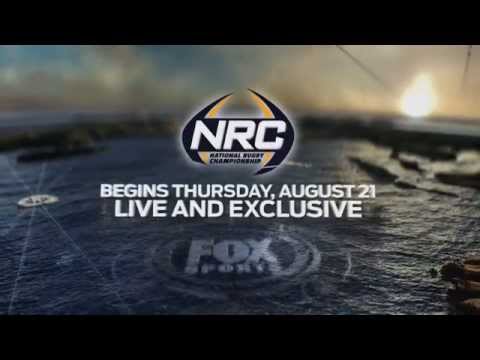
Sourced from: http://www.wn.com
Rumours have surfaced recently, suggesting financial backers Fox Sport and Foxtel were considering withdrawing their NRC support. Thankfully, the new Australian Rugby Union broadcasting deal has provided a five year extension, supporting a third-tier rugby competition in some form, until at least 2020.
So, if you were one of the unlucky fans who missed out on the NRC last year. Don’t make the same mistake in 2015!
When the season kicks off later this year, get down and watch some of the most entertaining rugby you will ever see.
Written by Nelson Dale
